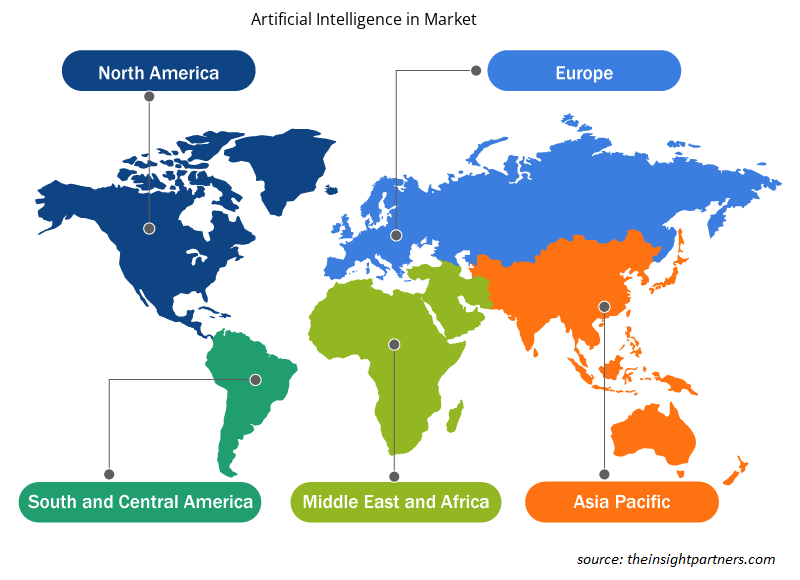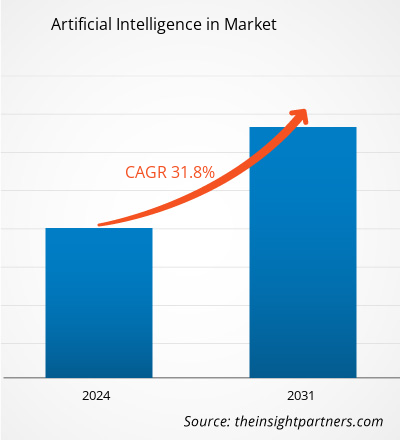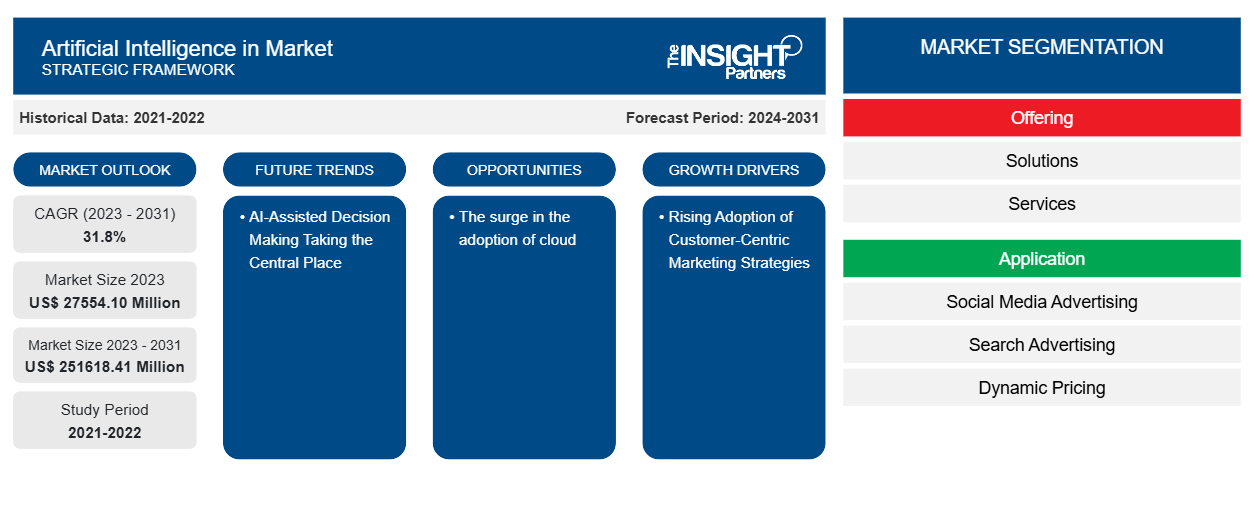预计到 2031 年,人工智能营销市场规模将从 2023 年的 275.541 亿美元增至 2516.1841 亿美元。预计 2023-2031 年期间市场复合年增长率将达到 31.8%。人工智能辅助决策占据中心地位很可能仍是市场的主要趋势。
人工智能在营销市场分析中的应用
社交媒体平台在广告中的使用日益增多,以及以客户为中心的营销策略的日益采用,是推动人工智能营销市场增长的因素之一。然而,精通人工智能知识的人才稀缺阻碍了市场的增长。此外,基于云的应用程序和服务的采用激增,为人工智能营销市场参与者创造了显着的机会。
人工智能营销市场概览
人工智能 (AI) 技术用于营销,以帮助基于数据收集、分析和可能影响营销活动的额外受众或经济趋势观察做出自动决策。当效率至关重要时,AI 经常用于数字营销活动。当速度在数字营销工作中至关重要时,经常使用生成式 AI。AI营销解决方案学习如何通过使用数据和客户资料最有效地与客户互动。然后,他们在适当的时间传递个性化信息,而无需营销团队人员的帮助,从而确保最佳生产力。大量现代数字营销人员使用生成式 AI 来支持他们的团队或开展需要较少人为细心的更多战术活动。
定制此报告以满足您的需求
您可以免费定制任何报告,包括本报告的部分内容、国家级分析、Excel 数据包,以及为初创企业和大学提供优惠和折扣
-
获取此报告的关键市场趋势。这个免费样品将包括数据分析,从市场趋势到估计和预测。
营销中的人工智能市场驱动因素和机遇
以客户为中心的营销策略日益受到青睐
为了在竞争激烈的全球市场中蓬勃发展,许多企业,无论属于哪个行业,都致力于与客户建立长期、互惠互利的关系。近年来,客户互动策略和行动的重点已从主要以产品为导向转变为更加以客户为中心。通过采用以客户为中心的方法,企业可以随时预测并更好地满足客户的需求。事实证明,有效过渡到以客户为中心的互动方式的公司具有显著的竞争优势,并增加了销售额和收入。据《哈佛商业评论》报道,超过三分之一的财富 500 强企业已以客户为中心进行重组,采用旅程、偏好和细分作为驱动原则。然而,近年来,许多知名公司已经有效地接受了以客户为中心的理念。美国受欢迎的以客户为中心的企业包括 USAA、Tumi 和美国运通。新加坡航空、新西兰航空和阿联酋航空等航空公司正在放弃传统方式,转而采用创新的广告形式。
云计算采用率激增
对于云用户来说,人工智能 (AI) 已经发展成为一种多功能工具,用于数据管理、安全、数据分析和战略决策。它掌握了使用机器学习和对数据驱动的洞察力进行客观解释的能力,提高了这些程序的效率,并为企业节省了大量资金。在云环境中利用基于机器学习算法构建的 AI 软件,公司可以为用户和消费者提供互联且用户友好的体验。因此,云计算采用的激增为市场创造了各种机会。
营销中的人工智能市场报告细分分析
促成营销市场分析中人工智能衍生的关键部分是供应、应用和最终用途行业。
- 根据产品,营销市场中的人工智能分为解决方案和服务。解决方案部分在 2023 年占据了更大的市场份额。
- 根据应用,市场细分为社交媒体广告、搜索广告、动态定价、虚拟助手、内容策划、销售和营销自动化、分析平台等。社交媒体广告领域在 2023 年占据了更大的市场份额。
根据最终用途行业,市场分为 BFSI、零售、消费品、媒体和娱乐等。
营销人工智能市场份额按地区分析
营销人工智能市场报告的地理范围主要分为五个地区:北美、亚太、欧洲、中东和非洲、南美和中美。
北美在营销人工智能市场中占据主导地位。Adobe、Amazon Web Services、IBM、Salesforce 和 Accenture 等营销人工智能市场的主要参与者一直在采用各种有机和无机策略来提高其收入和市场地位。例如,Appier 于 2021 年 1 月推出了 ARTIFICIAL INTELLIGENCEXPERT,这是一款基于人工智能的应用程序广告助手,可帮助营销人员通过 campArtificial Intelligencegns 轻松扩展其销售活动的绩效。因此,该地区的市场正在增长。
营销市场中的人工智能报告范围
市场区域洞察中的人工智能
Insight Partners 的分析师详细解释了预测期内影响人工智能市场的区域趋势和因素。本节还讨论了北美、欧洲、亚太地区、中东和非洲以及南美和中美洲的人工智能细分市场和地域。

- 获取市场中人工智能的区域特定数据
市场报告范围中的人工智能
| 报告属性 | 细节 |
|---|---|
| 2023 年的市场规模 | 27554.10 万美元 |
| 2031 年市场规模 | 251618.41 百万美元 |
| 全球复合年增长率(2023 - 2031) | 31.8% |
| 史料 | 2021-2022 |
| 预测期 | 2024-2031 |
| 涵盖的领域 |
通过奉献
|
| 覆盖地区和国家 |
北美
|
| 市场领导者和主要公司简介 |
|
市场参与者密度中的人工智能:了解其对商业动态的影响
人工智能市场正在快速增长,这得益于终端用户需求的不断增长,这些需求源于消费者偏好的不断变化、技术进步以及对产品优势的认识不断提高等因素。随着需求的增加,企业正在扩大其产品范围,进行创新以满足消费者的需求,并利用新兴趋势,从而进一步推动市场增长。
市场参与者密度是指在特定市场或行业内运营的企业或公司的分布情况。它表明在给定市场空间中,相对于其规模或总市场价值,有多少竞争对手(市场参与者)存在。
在市场上运营人工智能的主要公司有:
- 情感
- Appier 公司
- 比达尔戈
- Novantas(Amplero)公司
- 认知量表
- SAS 研究所
免责声明:上面列出的公司没有按照任何特定顺序排列。

- 了解人工智能市场顶级关键参与者概况
营销中的人工智能市场新闻和最新发展
营销市场中的人工智能通过收集一手和二手研究后的定性和定量数据进行评估,其中包括重要的公司出版物、协会数据和数据库。以下列出了营销市场中人工智能的一些发展:
- 全球领先的变革性情报提供商科睿唯安 (Clarivate Plc) 今天在 2024 年国际商标协会年会上发布了商标监测分析器 (Trademark Watch Analyzer) 的首个公开版本。作为由人工智能 (AI) 和云技术增强的下一代商标保护解决方案,该解决方案结合了科睿唯安全球商标和案例法数据、内部知识产权专业知识和尖端人工智能技术。它将通过自动执行关键商标监测任务并智能地对结果集进行优先排序,为关键业务问题提供更快、更准确的答案。(来源:Signify,新闻稿,2024 年 5 月)
- 全渠道客户互动公司 Emarsys 自 2020 年起成为 SAP 的一部分,该公司宣布推出 AI Product Finder,这是一款用于产品推荐和个性化客户体验的新解决方案。此举响应了消费者对商业人工智能的兴趣,Emarsys 的数据显示,64% 的消费者认为人工智能改善了他们的商业体验。(来源:Tungsram Group,新闻稿,2024 年 4 月)
营销市场中的人工智能报告范围和交付成果
“营销人工智能市场规模和预测(2021-2031)”报告对以下领域进行了详细的市场分析:
- 人工智能营销市场规模及预测,涵盖范围涵盖所有关键细分市场的全球、区域和国家层面
- 人工智能在营销市场趋势以及驱动因素、限制因素和关键机遇等市场动态中的应用
- 详细的 PEST/波特五力分析和 SWOT 分析
- 营销市场分析中的人工智能涵盖关键市场趋势、全球和区域框架、主要参与者、法规和最新市场发展
- 行业格局和竞争分析,涵盖市场集中度、热图分析、知名参与者以及营销市场人工智能的最新发展
- 详细的公司简介
- 历史分析(2 年)、基准年、预测(7 年)及复合年增长率
- PEST和SWOT分析
- 市场规模、价值/数量 - 全球、区域、国家
- 行业和竞争格局
- Excel 数据集
近期报告
客户评价
购买理由
- 明智的决策
- 了解市场动态
- 竞争分析
- 客户洞察
- 市场预测
- 风险规避
- 战略规划
- 投资论证
- 识别新兴市场
- 优化营销策略
- 提升运营效率
- 顺应监管趋势























 获取免费样品 - 营销市场中的人工智能
获取免费样品 - 营销市场中的人工智能